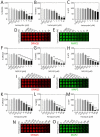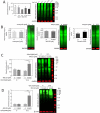Heat shock protein responses to aging and proteotoxicity in the olfactory bulb
- PMID: 25640060
- PMCID: PMC4464935
- DOI: 10.1111/jnc.13041
Heat shock protein responses to aging and proteotoxicity in the olfactory bulb
Abstract
The olfactory bulb is one of the most vulnerable brain regions in age-related proteinopathies. Proteinopathic stress is mitigated by the heat shock protein (Hsp) family of chaperones. Here, we describe age-related decreases in Hsc70 in the olfactory bulb of the female rat and higher levels of Hsp70 and Hsp25 in middle and old age than at 2-4 months. To model proteotoxic and oxidative stress in the olfactory bulb, primary olfactory bulb cultures were treated with the proteasome inhibitors lactacystin and MG132 or the pro-oxidant paraquat. Toxin-induced increases were observed in Hsp70, Hsp25, and Hsp32. To determine the functional consequences of the increase in Hsp70, we attenuated Hsp70 activity with two mechanistically distinct inhibitors. The Hsp70 inhibitors greatly potentiated the toxicity of sublethal lactacystin or MG132 but not of paraquat. Although ubiquitinated protein levels were unchanged with aging in vivo or with sublethal MG132 in vitro, there was a large, synergistic increase in ubiquitinated proteins when proteasome and Hsp70 functions were simultaneously inhibited. Our study suggests that olfactory bulb cells rely heavily on Hsp70 chaperones to maintain homeostasis during mild proteotoxic, but not oxidative insults, and that Hsp70 prevents the accrual of ubiquitinated proteins in these cells. The olfactory bulb is affected in the early phases of many age-related neurodegenerative disorders. Here, we described the impact of aging on multiple heat shock proteins (Hsps), such as Hsp70, in the female rat olfactory bulb in vivo. Using multiple proteasome and Hsp70 inhibitors (see schematic), we found that proteotoxicity elicited a compensatory increase in Hsp70 in primary olfactory bulb cells in vitro. Hsp70 then reduced the proteotoxic buildup of ubiquitinated proteins and robustly protected against cell death according to three independent viability assays. Thus, olfactory bulb neurons can mount impressive natural adaptations to proteotoxic injury, perhaps explaining why neurodegenerative disorders are so delayed in onset and so slow to progress.
Keywords: Glucose-regulated protein 78; heat shock cognate 70; heat shock protein 70; heme oxygenase 1; olfaction; proteostasis.
© 2015 International Society for Neurochemistry.
Figures






Similar articles
-
Heat shock protein defenses in the neocortex and allocortex of the telencephalon.Neurobiol Aging. 2015 May;36(5):1924-37. doi: 10.1016/j.neurobiolaging.2015.02.011. Epub 2015 Feb 18. Neurobiol Aging. 2015. PMID: 25771395 Free PMC article.
-
N-Acetyl cysteine blunts proteotoxicity in a heat shock protein-dependent manner.Neuroscience. 2013;255:19-32. doi: 10.1016/j.neuroscience.2013.09.049. Epub 2013 Oct 3. Neuroscience. 2013. PMID: 24096134
-
Synergistic stress exacerbation in hippocampal neurons: Evidence favoring the dual-hit hypothesis of neurodegeneration.Hippocampus. 2016 Aug;26(8):980-94. doi: 10.1002/hipo.22580. Epub 2016 Mar 29. Hippocampus. 2016. PMID: 26934478 Free PMC article.
-
Oxidative stress, mitochondrial dysfunction and cellular stress response in Friedreich's ataxia.J Neurol Sci. 2005 Jun 15;233(1-2):145-62. doi: 10.1016/j.jns.2005.03.012. J Neurol Sci. 2005. PMID: 15896810 Review.
-
Oxidative Stress and Protein Quality Control Systems in the Aged Canine Brain as a Model for Human Neurodegenerative Disorders.Oxid Med Cell Longev. 2015;2015:940131. doi: 10.1155/2015/940131. Epub 2015 May 11. Oxid Med Cell Longev. 2015. PMID: 26078824 Free PMC article. Review.
Cited by
-
Heat shock protein defenses in the neocortex and allocortex of the telencephalon.Neurobiol Aging. 2015 May;36(5):1924-37. doi: 10.1016/j.neurobiolaging.2015.02.011. Epub 2015 Feb 18. Neurobiol Aging. 2015. PMID: 25771395 Free PMC article.
-
Propolis supplementation attenuates the negative effects of oxidative stress induced by paraquat injection on productive performance and immune function in turkey poults.Poult Sci. 2017 Dec 1;96(12):4419-4429. doi: 10.3382/ps/pex248. Poult Sci. 2017. PMID: 29053856 Free PMC article.
-
Role of heat shock proteins in aging and chronic inflammatory diseases.Geroscience. 2021 Oct;43(5):2515-2532. doi: 10.1007/s11357-021-00394-2. Epub 2021 Jul 9. Geroscience. 2021. PMID: 34241808 Free PMC article. Review.
-
Hypertrophic cardiomyopathy in MYBPC3 carriers in aging.J Cardiovasc Aging. 2024 Jan;4(1):9. doi: 10.20517/jca.2023.29. Epub 2024 Jan 11. J Cardiovasc Aging. 2024. PMID: 38406555 Free PMC article.
-
Heat Shock Protein 70 as a Sex-Skewed Regulator of α-Synucleinopathy.Neurotherapeutics. 2021 Oct;18(4):2541-2564. doi: 10.1007/s13311-021-01114-6. Epub 2021 Sep 15. Neurotherapeutics. 2021. PMID: 34528172 Free PMC article.
References
-
- Aikawa S, Matsuzawa F, Satoh Y, Kadota Y, Doi H, Itoh K. Prediction of the mechanism of action of omuralide (clasto-lactacystin beta-lactone) on human cathepsin A based on a structural model of the yeast proteasome beta5/PRE2-subunit/omuralide complex. Biochimica et biophysica acta. 2006;1764:1372–1380. - PubMed
-
- Alladi PA, Mahadevan A, Vijayalakshmi K, Muthane U, Shankar SK, Raju TR. Ageing enhances alpha-synuclein, ubiquitin and endoplasmic reticular stress protein expression in the nigral neurons of Asian Indians. Neurochemistry international. 2010;57:530–539. - PubMed
-
- Alvarez-Erviti L, Rodriguez-Oroz MC, Cooper JM, Caballero C, Ferrer I, Obeso JA, Schapira AH. Chaperone-mediated autophagy markers in Parkinson disease brains. Archives of neurology. 2010;67:1464–1472. - PubMed
Publication types
MeSH terms
Substances
Grants and funding
LinkOut - more resources
Full Text Sources
Other Literature Sources
Medical
Research Materials
Miscellaneous

